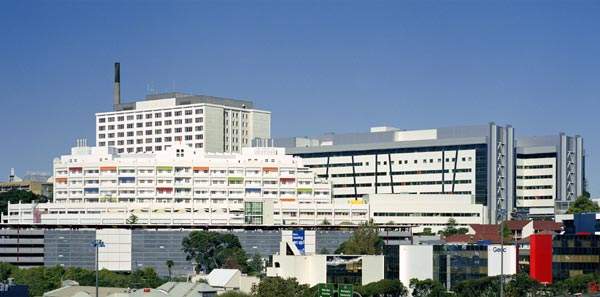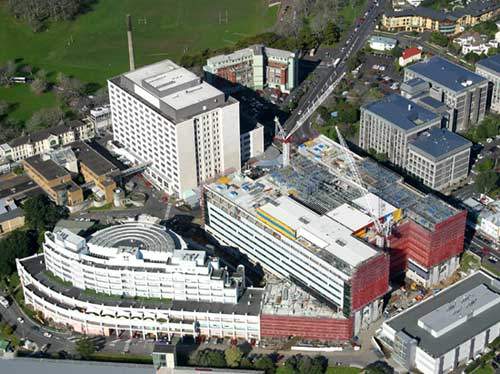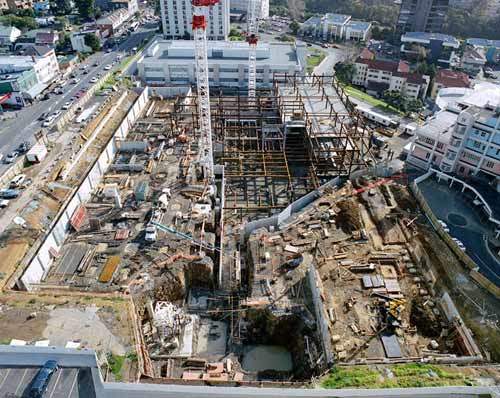Auckland’s new acute adult hospital on the Auckland District Health Board’s Grafton Road site opened on 3 October 2004.
It combines the services of Auckland, Green Lane and National Women’s Hospitals into one building, and links with Starship Children’s Health. It represents a fundamental reorganisation of the Auckland District Health Board’s staff and services.
HOSPITAL DESIGN
The new building is nine storeys high, five levels lower than the existing Auckland Hospital building. At around 80,000m², the new hospital is one of New Zealand’s largest public buildings.
The building makes maximum use of natural light – all the wards have access to it. The final design is an ‘H’ shape and has a very large internal courtyard which is again flooded with natural light. There is also a glassed atrium linked between the existing Auckland Hospital building (now known as the Support Building) and the new Auckland City Hospital.
The interior design uses warm colours and fabrics which ensure a welcoming environment for patients and visitors.
HOSPITAL IT SYSTEMS
Importantly, the hospital has put a lot of emphasis on IT, with a NZ$30 million IT spend spread over three years. Nigel Murray, the Auckland District Health Board’s building programme general manager has been quoted as saying that “NZ$10 million was spent on picture archiving, NZ$10 million on patient record scanning and NZ$8 million on patient clinical software, with the rest on infrastructure.” What could also be described as infrastructure, such as servers and other hardware, was included under picture archiving (of radiology images) and scanning where it was used for those projects.
Image archiving involved implementation of PACS (picture archiving and communication system) and record scanning was done under the banner of Creame (clinical record access made easy), a project to scan the mountain of paper patient notes held by the District Health Board.
The hospital uses HP iPAQ portables which Mayo-Smith says that, while they are less than ideal now, “another two generations of hardware will see far more effective use”. However, the fact the technology isn’t perfect yet doesn’t mean it shouldn’t be adopted now.
The iPAQs have the capability to offer biometric fingerprint user authentication, but that remains an option for the future, with no immediate plans to replace passwords, he says.
Before the IT could be applied the hospital had to install 10,000 jack points or individual cable runs, 80,000m of 4pr UTP Cat 5e cable, 6,000m of 12 core MM fibre cable, 6,000m of 100 pair voice cable, 20 communication cabinets, 13 hub rooms, wireless access points and a public address system with over 900 speakers. IBM was also required to install a master antenna system for 1,000 television sets.
OPENING THE NEW HOSPITAL
The hospital was opened with considerable celebration in October 2004. However, it has not all been smooth sailing. The hospital’s head acute orthopaedic clinician says his patients will suffer from the minute they make the move: “It has 50 beds and we’re looking after 72 patients every day…We won’t even be able to get into the unit that’s supposed to service Auckland for the next 30 years,” he said.
He commented that many people will have to be farmed out to other wards. “Someone will be severely compromised or have some permanent disability because we were operating in a system we have no control over.”
There have been other problems: the sterile supply department has not been functioning brilliantly (one MP called it “third world”) and the new computer systems have had “teething problems” which has caused delays. There has also been a shortage of nursing staff.
Perhaps the biggest challenge has been an internal audit report into questions over a NZ$17 million deal with its biggest supplier. The report, ordered by the Auckland District Health Board, says its two leading executives were compromised by their connections to their health board’s main supplier.
The report reveals the most information yet about the circumstances leading to the resignations of its former chief executive, Graeme Edmond, and its former chief financial officer, Ian Ward. The pair quit in 2003 after allegations of a conflict of interest in the directorships they held in Health Support Ltd, the board’s largest supplier with contracts worth NZ$38 million, the largest valued at NZ$17 million.










